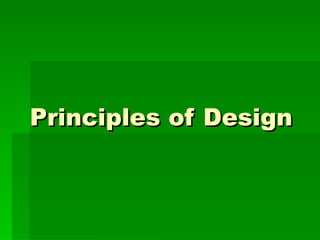slideshow4
- 2. The Principles are concepts used to organize or arrange the structural elements of design. Again, the way in which these principles are applied affects the expressive content, or the message of the work. Balance Proportion Rhythm Emphasis Unity
- 3. Balance Most successful compositions achieve balance in one of two ways: symmetrically or asymmetrically.
- 4. Symmetrical balance can be described as having equal "weight" on equal sides of a centrally placed fulcrum. It may also be referred to as formal balance
- 5. Asymmetrical balance also called informal balance , is more complex and difficult to envisage. It involves placement of objects in a way that will allow objects of varying visual weight to balance one another around a fulcrum point
- 6. Some form of balance is needed in any good composition.
- 7. The Lady of Shalott J.W.Waterhouse Diego Rivera (dÃŽa de las flores)
- 8. Proportion Proportion refers to the relative size and scale of the various elements in a design. The issue is the relationship between objects, or parts, of a whole. This means that it is necessary to discuss proportion in terms of the context or standard used to determine proportions.
- 9. Our most universal standard of measurement is the human body; that is, our experience of living in our own bodies In the work of the Renaissance artists, this proportion was seen as divine, and they continue to influence all art and architecture to this day.
- 10. As we already looked at churches and places of worship art made to a scale that dwarfs the human proportion.
- 11. Nowadays big business (perhaps the religion of the 21 st century) use the same concepts in the design of their centres of worship.
- 12. In contrast, the proportions of a private home are usually more in scale with human measure, and as a result it appears more friendly, comfortable, less intimidating
- 13. Use of appropriate scale in surface design is also important. For example, an overly large textile design can overwhelm the form of a garment or a piece of furniture
- 14. A surprising aspect of proportion is the way ideal proportions can vary for the human body itself. Styles change in bodies as they do in clothing. Prior to the 16th century, for example, the female body ideally had large hips and belly. Only later was a small waistline stressed.
- 15. In the 17th century and many other periods, the ideal body was much heavier than we would accept today.
- 16. Men have not escaped this change in ideals Michelangelo 's David , sculpted from 1501 to 1504 Myron Discobolus 5th century BCE
- 17. Televised sport coverage of popular games such as football and rugby started the male fitness craze of the 80âs and lead toâĶâĶ.
- 18. But things are changing back, sports such as basketball, famous music groups and actors have changed again the ideal of human body proportions, both for men and women.
- 19. In addition, artists frequently take liberties with the natural proportions of the human body to achieve their expressive goals.
- 20. Rhythm
- 21. Rhythm can be described as timed movement through space; an easy, connected path along which the eye follows a regular arrangement of motifs. Rhythm depends largely upon the elements of pattern and movement to achieve its effects
- 22. Emphasis Emphasis is also referred to as point of focus It marks the locations in a composition which most strongly draw the viewers attention. Usually there is a primary, or main, point of emphasis, with perhaps secondary emphases in other parts of the composition
- 23. Ėý
- 24. Unity Unity is the underlying principle that summarizes all of the principles and elements of design. It refers to the coherence of the whole , the sense that all of the parts are working together to achieve a common result; a harmony of all the parts.
- 25. It may be unity of colour and pattern
- 26. It may be unity of proportion and shape (La tentazione di Sant' Antonio) -. Dali
- 27. Unity can also be a matter of concept The elements and principles can be selected to support the intended function of the designed object; the purpose of the object unifies the design.
- 28. Creativity is a quality that is highly valued, but not always well understood. Those who have studied and written about it stress the importance of a kind of flexibility of mind. Studies have shown that creative individuals are more spontaneous, expressive, and less controlled or inhibited. They also tend to trust their own judgment and ideas-- they are not afraid of trying something new
- 29. Creativity = original ? A common misunderstanding equates creativity with originality. In point of fact, there are very few absolutely original ideas Most of what seems to be new is simply a bringing together of previously existing concepts in a new way It is possible to develop ones ability to think intuitively and creatively




























